Colloquia for Fall 2018
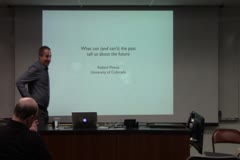
What can (and can't) the past tell us about the future?
December 17, 2018
Robert Pincus
Hosted by Christine Chiu
Changes in the composition of the atmosphere cause changes to the planetary radiation budget to which the Earth responds by changing its temperature; changes in temperature may also change the atmosphere's opacity in ways that damp or amplify the temperature change. This framework — radiative forcing, adjustments, and feedbacks — provides a useful lens through which to think about future…
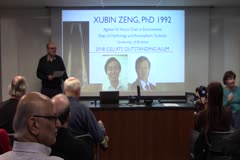
Interface Processes in the Earth System
December 07, 2018
Xubin Zeng, Visiting ATS from the University of Arizona
Hosted by Jeff Collett
The Earth system includes the atmosphere, ocean, land, and ice. These components interact with each other through interface fluxes. Here I will highlight some of my group’s work on interface processes along with future directions:
- Solution of a problem in land-atmosphere interaction that has accelerated the satellite data assimilation and improved weather forecasting over arid…
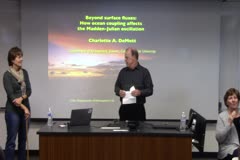
Beyond Surface Fluxes: How Ocean Coupling Affects the Madden-Julian Oscillation
November 26, 2018
Charlotte DeMott
Hosted by David Randall
The intraseasonal (30-70 day) Madden Julian oscillation (MJO) regulates cloudiness, rainfall, and winds throughout the Tropics. Its effects are communicated to higher latitudes via teleconnections where it influences the likelihood of extreme weather events. Simulation and prediction of the MJO remain an outstanding challenge for climate and forecast models. The organization of MJO convection…
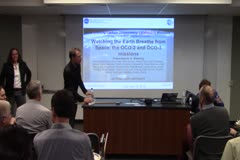
Watching the Earth Breathe from Space: The OCO-2 and OCO-3 missions
November 16, 2018
Annmarie Eldering, Visiting ATS from NASA/JPL
Hosted by Chris Kummerow
Global carbon dioxide measurements by the Orbiting Carbon Observatory-2 and the upcoming Orbiting Carbon Observatory-3 are a new way to watch the earth breathe from space. These missions are motivated by the large, yet poorly understood, interannual variability in the fraction of human CO2 emissions that are removed by plants and the ocean each year. I will discuss the measurements technique,…
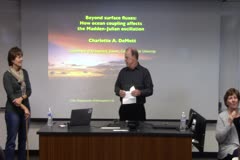
Beyond Surface Fluxes: How Ocean Coupling Affects the Madden-Julian Oscillation
November 09, 2018
Charlotte DeMott
Hosted by David Randall
The intraseasonal (30-70 day) Madden Julian oscillation (MJO) regulates cloudiness, rainfall, and winds throughout the Tropics. Its effects are communicated to higher latitudes via teleconnections where it influences the likelihood of extreme weather events. Simulation and prediction of the MJO remain an outstanding challenge for climate and forecast models. The organization of MJO convection…
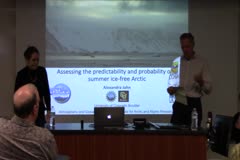
Assessing the Predictability and Probability of a Summer Ice-Free Arctic
November 02, 2018
Alexandra Jahn Visiting ATS from the University of Colorado Boulder
Hosted by Eric Maloney
How predictable are future changes in Arctic sea ice, and in particular the occurrence of ice-free conditions in the summer? I will answer this question using ensemble simulations from the Community Earth System Model (CESM) forced by a range of emission pathways, resulting in global temperature changes of 1.5°C to 4.5°C above pre-industrial by the year 2100. I will show that after 2045,…
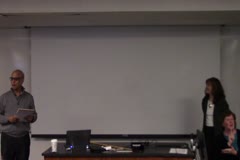
A New Look at Old Air in the Stratosphere: Radiocarbon Production and Transport to the Troposphere
October 12, 2018
Kristie Boering, Visiting ATS from the University of California, Berkeley
Hosted by Jeff Collett and A. R. Ravishankara
The redistribution of 14CO2 from atmospheric nuclear weapons testing has long been used to quantify the inventories, residence times, and gross fluxes of carbon in and between the stratosphere, troposphere, oceans, soils, plants and other reservoirs. Now, five decades after the Limited Test Ban Treaty restricted above-ground nuclear weapons detonations, the natural cosmogenic 14C production…
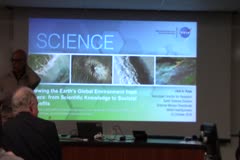
Viewing the Earth's Global Environment from Space: from Scientific Knowledge to Societal Benefits
October 11, 2018
Jack A. Kaye, Associate Director for Research, Earth Science Division NASA HQ – Science Mission Directorate
Hosted by A. R. Ravishankara
The vantage point of space provides a unique opportunity to see all the elements of the global Earth system – atmosphere, ocean, land surface, ice, biosphere – and how they interact with each other. The ability to characterize both natural processes and those caused by humans, as well as the ability to study processes on a range of time scales from days to decades, helps scientists…
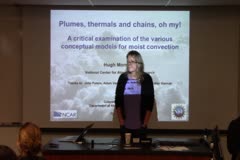
Plumes, Thermals and Chains, Oh My! A Critical Examination of the Various Conceptual Models for Moist Convection
October 05, 2018
Hugh Morrison, Visiting ATS from NCAR
Hosted by Sue van den Heever
Since the 1950s, two primary conceptual models have served as a basis for understanding the structure and behavior of moist convection in the atmosphere. The first is the steady-state plume, and the second is the isolated rising thermal. These models have markedly different structural and flow characteristics, and debate has continued as to which one provides a better framework for…
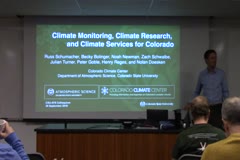
Climate Monitoring, Climate Research, and Climate Services for Colorado
September 28, 2018
Colorado Climate Center Staff
Hosted by Russ Schumacher
The Colorado Climate Center, based in the Department of Atmospheric Science at Colorado State University since 1973, has a threefold mission to serve our state. We are responsible for monitoring the state’s weather and climate, including analyzing trends and extremes and operating two of our own weather observing networks; for conducting applied research toward improved understanding and…
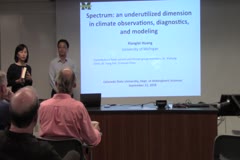
Spectrum: An Underutilized Dimension in Climate Observations and Modeling
September 21, 2018
Xianglei Huang, Visiting ATS from the University of Michigan
Hosted by Christine Chiu
While broadband flux has been widely used in climate studies, its integrand, the spectral flux, has not been fully utilized in climate studies. An important trait of spectral diagnostics is that they can reveal compensating biases, which cannot be revealed by broadband diagnostics alone. I will first describe an algorithm developed in my group to derive such spectral flux from currently…
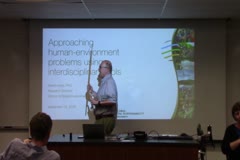
Approaching Human-Environment Problems Using Interdisciplinary Tools
September 14, 2018
Pat Keys, Visiting ATS from CSU’s School of Global Environmental Sustainability
Hosted by Jeff Collett
Solving problems related to human-environment interactions, such as water security challenges or ocean fisheries collapse, often requires interdisciplinary approaches. In this seminar, I will highlight two novel approaches for addressing complex human-environment problems. Water security is a current buzzword, often closely linked to how humans use surface water resources. However,…
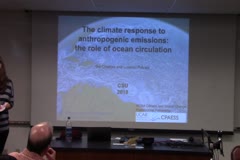
The Climate's Response to Anthropogenic Emissions: The Role of Ocean Circulation
September 07, 2018
Rei Chemke, Visiting ATS from the Lamont-Doherty Earth Observatory
Hosted by Elizabeth Barnes
The effects of ocean circulation on the climate's response to anthropogenic emissions at low and high latitudes are examined. At low latitudes, the Hadley cell plays an important role in setting the strength and position of the hydrological cycle. Climate projections show a weakening of the Hadley cell, together with widening of its vertical and meridional extents. These changes are projected…
